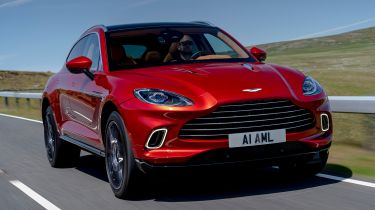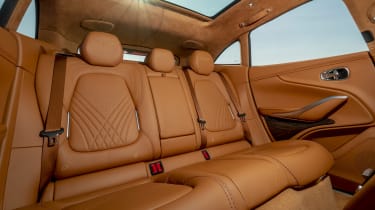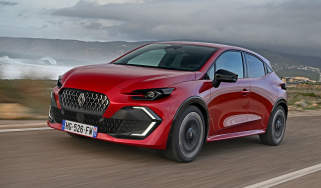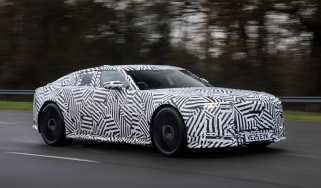Aston Martin DBX review: a luxury SUV with a sports car attitude
Its looks may divide opinion, but the DBX does all the things you’d want a luxury SUV to do, with added Aston Martin magic

The Aston Martin DBX delivers all the practicality and refinement you’d expect from a luxury SUV, with a driver-focused approach that sets it apart from its closest rivals. The British sports car manufacturer has gone with what it knows best — applying its technical wizardry to produce the finest-handling SUV available.
Yes, the DBX is well over two tonnes and will seat five in comfort, but it remains an incredibly deft machine. It will certainly make you smile as it effortlessly deals with a twisty B road, while a seemingly boundless amount of power rockets you out of the tightest of bends. It’s less brash than a Lamborghini, not as bold as a Bentley and not as commonplace as a Porsche. They’re all super-quick, but all ultimately out-handled by the Aston Martin.
About the Aston Martin DBX
As more and more sports car and luxury car brands turn to building SUVs in order to boost sales and help bring in higher profits, the DBX marked Aston Martin’s debut in this area of the market when it first arrived in 2020.
The DBX faced intense competition from day one. Porsche is credited with creating the performance crossover blueprint with the Cayenne, and the latest version continues to be a strong seller for the brand. Porsche’s success also paved the way for similarly luxurious SUVs such as the Bentley Bentayga and Maserati Levante, and even Lamborghini has jumped on the bandwagon with the outlandish Urus.
Used - available now

2024 Aston Martin
DBX
20,000 milesAutomaticPetrol4.0L
Cash £89,990While these rivals make up the more salubrious end of the performance SUV market, other brutish competitors such as the Range Rover Sport SV and BMW X5 M60i lower down the price range.
The DBX pitches in from just under £180,000, and going anywhere near the options list will quickly drive this price upwards. What you get for your money is a distinctive five-door SUV with 542bhp and a sizable 700Nm of torque. But, it’s not just the Mercedes-AMG 4.0-litre petrol V8 powerplant that delivers the driving enjoyment, because Aston Martin has worked hard to transfer its sports car know-how into its SUV, and the tech hidden under the skin ensures it’s every bit as capable as the smaller members of its line-up.
Power is delivered via a nine-speed automatic gearbox, which allows the DBX to dispatch the 0-60mph sprint time in 4.3 seconds, before firing on to reach a top speed of 181mph - not bad for a luxurious SUV that’s practical enough for family life.
If those figures are mere child’s play in your eyes, the hotter DBX707 is the car for you. The Mercedes-sourced V8 is tweaked to produce an even crazier 697bhp and 900Nm of torque, plus it’s had numerous adjustments to the car’s aerodynamics and suspension components in a bid to boost handling. The result is a 2.2-tonne SUV that will happily sprint from 0-62mph in a mere 3.3 seconds, and then proceed all the way up to 193mph. Who said supercar performance can’t come with boot space? Just be prepared to part with nearly £200,000.
Engines, performance and drive
There’s no escaping from the fact that the Aston Martin DBX is a big, heavy SUV, so it’s fortunate to have had the expertise of one of the world’s best sports car makers to hone its development. Despite weighing over 2.2 tonnes, the DBX remains light on its feet and, in a hugely talented class, it feels more in keeping with a fast estate like an Audi RS 6 Avant or Mercedes-AMG E 63 – possibly even an RS 4 or C 63. It’s that nimble and agile for its size.
Aside from using the 4.0-litre V8 engine from Mercedes-AMG, the Aston Martin engineers have also equipped the DBX with a host of impressive tech trickery to ensure it cuts the mustard on tight, twisty roads. Features such as triple-chamber air suspension, electronic adaptive dampers and a 48v electric anti-roll control system (called eARC) are some of the reasons why the DBX triumphs over its rivals in the handling stakes.
There are six driving modes available for the DBX, although the Individual setting could well be the preferred option. Here, you can tune the chassis and steering to comfort, up the response from the engine and gearbox and have the exhaust on its most tuneful setting - just perfect.
The DBX’s steering is quick, with plenty of feel to help you recognise if you’ve pushed things too far. More important is the car’s ability to respond swiftly to throttle inputs, delivering a healthy and linear dose of power.
It’s impressive enough already, but in 2022, the DBX707 arrived to push this luxury SUV to the ultimate limit. It weighs the same, but several tweaks to the steering, suspension, aerodynamics and the V8 engine combine to produce a family-friendly car that’ll quite happily trouble several supercars.
Perhaps the most surprising thing about the DBX707 is that it’s just as comfortable, spacious and surprisingly easy to live with as the standard car. However, fuel economy of under 20mpg isn’t exactly frugal.
Engines, 0-60 acceleration and top speed
The DBX isn’t the quickest super-SUV in a straight line – its 4.0-litre V8 petrol unit produces 542bhp and manages 0-62mph in 4.5 seconds. It’s still a rapid sprint time, although not quite up to the 3.6-second dash set by the Lamborghini Urus. Top speed for the standard DBX is 181mph.
Not to be outdone by the Lamborghini Urus, the DBX707 has a shockwave-inducing 697bhp and 900Nm of torque on tap. All that power means 0-62mph is dealt with in just 3.3 seconds, and a top speed of 193mph.
MPG, CO2 and running costs
The Aston Martin DBX has a starting price of around £180,000, but as with its Lamborghini Urus rival, that’s just the start. There’s an array of accessory packs and optional equipment to choose from, and Aston Martin’s Q Division is also on hand to personalise your DBX down to the last detail. Buyers should expect that even with just a few choice options ticked, the price could easily reach £200,000 or more.
The mounting cost of DBX ownership continues when you factor in that the claimed fuel economy is just 19.8mpg on the combined cycle. Anyone choosing to exploit the power on offer from the two-tonne SUV may see this fall to single figures. Still, with a light right foot, you might be able to eke out around 370 miles from the 85-litre tank. Emissions are unsurprisingly high at 323g/km, so don’t expect to beat any city congestion charges when driving a DBX.
You’ll also need to consider the premium servicing costs involved in running a bespoke, British-built luxury SUV, and the expensive consumables like tyres and brake pads. All of these will need regular attention if you intend to drive the DBX to its full potential.
Insurance groups
There’s a definite theme to the ownership of an Aston Martin DBX – it’s expensive. The SUV sits in the highest group 50 for insurance, as do all of its rivals, so expect costly premiums.
Depreciation
As a fairly low-volume car, the DBX performs reasonably well on the used market in terms of resale values. However, Aston Martin ownership starts with a high list price and encourages you to add expensive options, so you’ll still probably be looking at a hefty chunk of money lost. Our expert data suggest that the DBX should retain around 61 per cent of its initial value after three years and 36,000 miles.
To get an accurate valuation on a specific model check out our free car valuation tool...
Interior, design and technology
From the outside, it’s clear that the DBX is an Aston Martin. The familiar style and design flourishes are particularly evident through the front end, leaving a much more subtle impression than that conveyed by its shouty competitors. Aston’s design team wanted the DBX to look smaller than it actually is, and they appear to have succeeded with the SUV seeming relatively svelte and stylish compared to the big, brash nature of so many other high-end 4x4s.
Inside, the full-length panoramic roof bathes the car in light, and you’ll find great swathes of leather across most of the cabin. The rest is a mix of metallic and piano black finishes, although you can have your DBX any way you fancy – at a cost. Overall quality is good, but it doesn’t do enough to trouble the Bentley Bentayga in this regard.
The engine start button sits at the top of the dash, flanked by P, R, N and D buttons to control the gearbox. A 10.25-inch full-colour TFT screen sits in front of the driver as the main instrument binnacle.
The standard kit is well taken care of and includes front and rear heated seats, 3-zone climate control, a powered tailgate, auto LED headlights and a 360-degree camera.
Sat-nav, stereo and infotainment
Aston has had to rely too much on Mercedes with the DBX’s switchgear. The centre console is a touch fussy, and is strewn with small buttons that are difficult to differentiate. While the 12.3-inch infotainment screen does come with Apple CarPlay, it’s a generation behind Mercedes’ current models. It’s disappointing that the screen can only be operated by the control wheel and touchpad, because most people (including us) naturally try prodding the display first.
The standard Premium Audio System includes 14 speakers and a 800w total output, while there are also four USB ports for smartphone connectivity.
Practicality, comfort and boot space
Switch the Aston Martin DBX’s drive mode to Terrain+, and you’ll be able to go further than most owners will ever want to. It has decent approach and departure angles of 22.2 and 24.3 degrees, respectively, and a breakover angle of 15.1 degrees – with the suspension raised by 45mm. If you really wanted to, you can also wade at a depth of up to 500mm.
In terms of ride comfort, the DBX sits somewhere between the grand touring DB11 and the focused Vantage; it is never uncomfortable, but always alert. Is it as smooth as a Bentley? No. Is it as firm as a Urus? No. In truth, it’s a rather unique blend of the two – it never dismisses bumps, instead constantly reminding you of the quality of the road surface.
Visibility is good forwards and backwards, with a suite of cameras there to help out when you’re parking up. It also does the day-to-day things you need your SUV to do well. Access is easy, with the car dropping 50mm on its air suspension. Open the frameless door – which covers the door sill to keep your legs clean when getting in and out – and there’s a flat floor with no sill to climb over.
Dimensions and size
At 5,039mm, the DBX is only 101mm shorter than a Bentley Bentayga, yet it handles more like a fast estate car than an SUV. The overall width (including mirrors) is 2,220mm, almost identical to the Bentayga.
Leg room, head room & passenger space
The DBX is a full five-seat SUV, although long journeys with three adult passengers in the rear may prove a little tiresome. There’s plenty of space upfront, and headroom is fine, despite the DBX having a lower roofline than most rivals.
Boot space
Boot space in the DBX is a practical 638 litres. In comparison, the Bentayga has just 484 litres of loadspace, while the Urus provides a more useful 616 litres. The rear seats in the DBX also split-fold in a 40/20/40 formation, allowing for more luggage space if needed.
Towing
Aston Martin states that both versions of the DBX can tow up to 2,700kg – so you can easily transport your track day pride and joy in a covered trailer. However, if you need more pulling power, the Bentayga can tow up to 3,500kg.
Reliability and safety
Running the Mercedes-AMG 4.0-litre V8 petrol engine should point to a level of tried and trusted reliability for the Aston Martin DBX, while Aston itself has developed the car from the ground up and will be demanding nothing less than a dependable, volume-selling product.
Due to the relatively low number of sales compared to other mainstream models, the DBX probably won’t be tested by industry safety experts, Euro NCAP. However, in addition to the raft of front, side and curtain airbags, there are additional active safety features as standard, including adaptive cruise control, lane-keeping assist and auto emergency braking with pedestrian detection. The list of safety tech continues with systems such as traffic sign recognition, lane departure warning, rear cross traffic warning and blind spot detection.
Warranty
Aston Martin provides owners with a three-year, unlimited-mileage warranty and the option of extending the cover for 12 or 24 months when it expires.
Servicing
Scheduled servicing costs are fixed, with Aston suggesting V8-powered vehicles are seen by approved technicians annually or every 10,000 miles.





